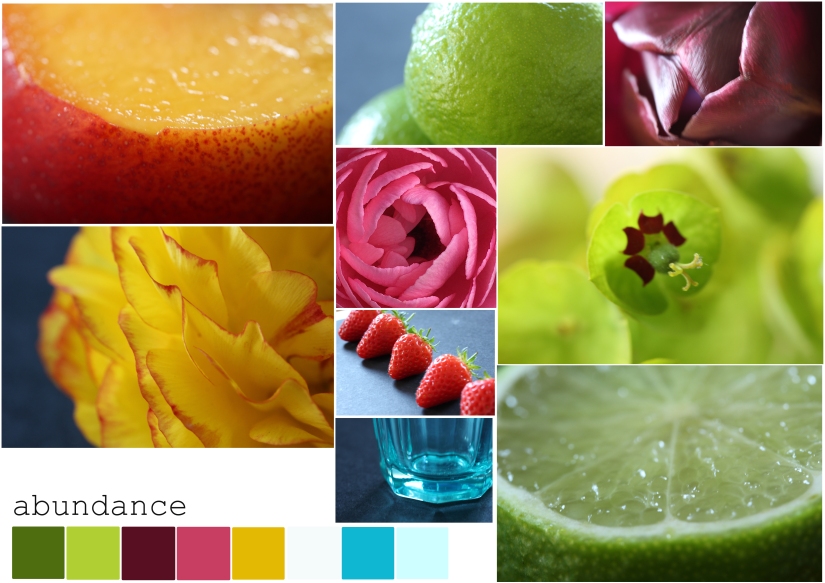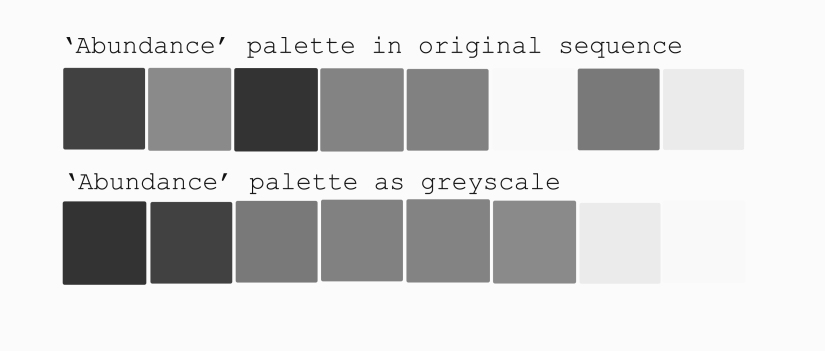I received feedback from a number of fellow students on each of my palettes and the imagery and draft mood boards I posted for each (see previous posts). This is a summary of my response in terms of refining the palettes and imagery plus the final palette I settled on for each trend. The final imagery will be shown in my Trend Book for 1.6.
Abundance
Key points of feedback were:
- good colours, lively, contemporary
- sense of spring, freshness, ‘juicy’, tropical comes across – change the title of the trend?
- remove the ‘harvest’ element of the description as it’s misleading
- need more sense of abundance rather than details of individual fruits – images of growth to connect with this aspect of concept
- individual colours questioned – do you need the blue? pink? should a red be included? or colours could be added eg the slate blue from the background
I spent a lot of time working in my sketchbook and digitally testing out these ideas, taking additional images and refining the palette. I narrowed down my written description, removing the ‘harvest’ element as this seemed to lead in a conflicting direction conceptually and in terms of colour and layout; researching the definition of ‘abundance’ led me to change the title to ‘plenty’ which is more direct. I decided to keep the full range of colours as they capture the intensity of my original concept – it needs the blue, pink, yellow AND green – and because I am likely to be working in mini palettes in Part Two which will allow me to select from a wider choice.

Given time I would get out and about with my camera to widen the range of imagery – more abundance and growth. Further developments of the imagery could include:
- images of market stall, fruit in baskets etc (thanks, Nicki) to give more variation to the close up imagery & suggest context; fewer flowers, different produce
- pay closer attention to the background of the images so this reflects a key colour too
During my sketchbook work I started playing with materials and their qualities; the concept suggests smooth, shiny surfaces and pliable materials – acetate, liquids, plastics, the PVA ‘threads’ I created for IAP5 – and I found this very exciting. This will be followed up in Part Two.
Believe
Finding suitable imagery was initially a struggle for this concept because of the abstract nature of the concept. Feedback from my peers focused on the photos I was using but confirmed my colour selection, especially the decision to include the green as an accent colour.
To refine the palette I’ve focused on exploring the disconnect between the paint and digital palettes which was at the heart of the problem, and this has led me to imagery that better conveys the concept. In developing my third palette, Protest, I found focusing on a single inspirational image helpful so for Believe I went back to my favourite image of a Krishna event and created a palette solely from this image to see if that clarified my thinking; I then added this palette to some of my existing imagery:
This is a more harmonious, simple palette than my original. However, in working purely digitally I felt I’d lost touch with my original concept; returning to paint and sketchbook I looked at the gap between digital and physical colour (exaggerated further by the photography here). I returned to the gouache swatches and realised that I needed to de-saturate the digital colours to achieve the subtlety I needed. In particular, I felt that the quick abstract ‘paintings’ I’d done whilst playing with the gouache captured the warmth and texture I wanted for the concept which are missing from the digital version. Although the palette of harmonious pinks from the Krishna image is very attractive, I’ve decided to stick to the more challenging palette I originally generated (see gouache and desaturated digital palette below).


Protest
For feedback on this trend, comments on the CC email thread supported my choices and imagery, while questioning the precise tone of red, suggesting it could be stronger, more blood-like. The palette is described as ‘strong’ and ‘exciting’; one student, Claire, made really helpful suggestions re texture – glossy for the red and concrete/matt/linen for the greys. In addition I had a wonderfully detailed 20 minute discussion with fellow student, Inger. My notes are below:
In particular, this discussion confirmed the nature of the red I’d chosen – what Inger described as ‘French red’ for passion not USA stars and stripes red. My main concern about the palette had been not wanting to evoke the nationalism that can be connoted by flags, whilst acknowledging that the flag is often used as a symbol of resistance and protest – Inger pointed me to Delacroix’s ‘liberte’ image.

This discussion also made me wonder whether to change the title to ‘Resist’ as I feel this maybe more accurately describes what I’m thinking of but in the end it feels rather passive compared to ‘protest’. However, I’m keen to avoid any rather brutal or simplistic harshness in the colours, hence the red which I hope avoids direct connotations of bloodshed or violence. Our discussion also confirmed the exact shades of grey I’d chosen (which took a very, very long time to mix!) – as well balanced between cool and warm, and inherently ‘calm’ rather than ‘soft’ as the latter would undermine the protest element.
My explorations of this palette led me almost immediately to non-textiles materials and 3D work (see mood board) and I am keen to explore this further in Part Two. My final Protest palette remains unchanged:

Conclusions and evaluation
I think I have a varied but coherent trio of palettes that feel quite ‘me’ – placing them alongside each other is quite exciting. Each is distinct – Plenty is more saturated, Believe more subdued and muted and Protest more of an exploration of tonality with accents:

What I’ve learned from this process:
- feedback is very helpful in the developmental stage; face to face discussion is invaluable
- trust my instinct re colour and keep a focus on the original concept/descriptive words to ensure later work stays true to this especially once I move into digital interpretations
- I need to develop my digital skills to find a way to express concept, texture and subtle ideas – initially, moving into digital palettes led me to oversimplify and wander a little from the original concept (eg the ‘juicy’ element of the first palette, being drawn by some lovely photos; over-saturating the palette for Believe); I can do this through layering, using my graphics tablet for more free drawing and generally focusing on expressiveness and experimentation rather than the visual ‘perfection’ that digital work tends towards – especially, this is the way I’ve used digital in my day job, for ‘professional presentation’ and photography rather than expressiveness
- keep playing with materials – as soon as I focused on materials (fabric, paint, acetate) for each palette, it came alive and became much more playful and exciting and allowed me to express quality through form and texture as well as colour; see digital as a material and process rather than simply a presentation device







































